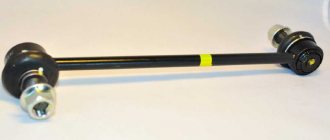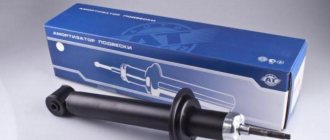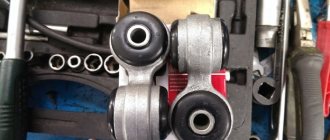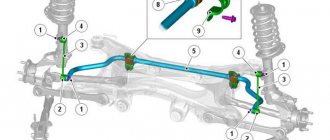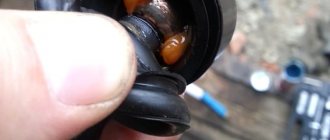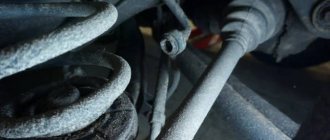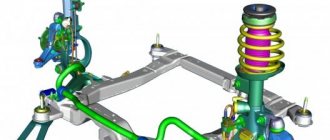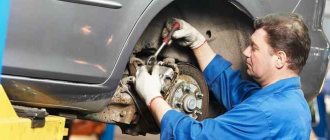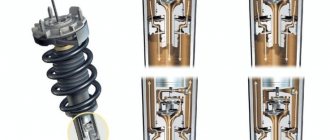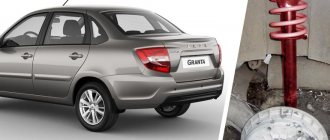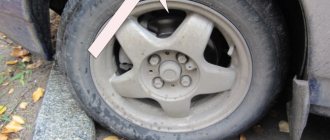Improving vehicle performance is one of the most important tasks of manufacturers, so a lot of money is invested to ensure them. We are talking about comfort of movement, reliability and ease of driving. Responsibility for these criteria rests with the car's suspension. Diagnostics and replacement of front stabilizer struts, as well as shock absorbers and other elements of the damping system, is an important component in maintaining the chassis. More details on how to replace the front stabilizer struts with your own hands will be discussed in this article.
Stabilizer strut structure
The main task of the stabilizer struts is to dampen the translational waves that arise in the car’s suspension when driving over uneven surfaces. The racks are fixed thanks to special lugs located in the rear and front parts of the suspension. Despite the strength of the part, they have a service life of 100-120 thousand km. Of course, the service life may vary depending on certain factors (driving style, part manufacturer, etc.).
Stabilizer strut device
Damage or wear of the anti-roll bar can lead to the car tipping over, because when turning, the load will not be distributed between the elastic elements of the suspension. Therefore, it is important to change the part in a timely manner - this will avoid machine breakdown or accident.
Features of the front stabilizer bar of Toyota Yaris
How to replace stabilizer bushings?
You can find detailed instructions for replacing bushings here.
What to do if it is impossible to purchase by article number
The solution will be to select the required part according to its size. Just unscrew it and measure well on all sides. There are specialized sites where the procedure is automated. For example, ]VTR[/anchor] invites its customers to choose a suitable solution on the official portal - https://vtr.su/shop. Go to the appropriate section and enter the necessary parameters:
By clicking on the corresponding link on the screen, you can obtain information on the selected part. For example, dimensions of AU3903S:
You can also select according to existing sizes. For example, on the site https://xn--80aafnj4alqen.xn--p1ai/?form=1&idd=21. It is enough to indicate the length and rotation angle in the appropriate fields:
This is enough to obtain information on the details. It is important to note that service life greatly depends on the quality of the material used. There are a number of other factors that influence operation. You need to carefully monitor the condition of the suspension.
Symptoms of a problem
Stabilizer links are subject to heavy loads, especially if the car is driven on uneven road surfaces. Over time, many motorists, especially novice drivers, face the consequences of careless driving.
Signs of a faulty stabilizer link
The following signs indicate a malfunction of the front stabilizer struts:
- increased roll when cornering;
- “floating” of the car when driving in a straight line (the driver has to constantly steer the car to catch the track);
- car skidding when turning;
- the appearance of a knock in the suspension when driving on an uneven surface;
- strong swaying of the car body when braking and starting.
Worn stabilizer links
Note! Even if the suspension works normally off-road, when you hit a speed bump, characteristic knocks may appear in the area of the stabilizer bar.
Signs of wear on the stabilizer link
Rating of stabilizer struts
Below is a list of stabilizer struts by rating:
- Lemforder (Lemforder). Country: France. Such racks are purchased from them by manufacturers General Motors, Mitsubishi, Toyota, Opel, Volkswagen, Mersedes-Benz, Audi, BMW, Ford, Volvo, Fiat and some other brands. Reputable quality and good resource.
Reviews (+) Reviews (-) Lehforbeck tested it in an Opel Omega B, Opel Vectra C, Huyndai Santa Fe New. Had no problems with them either. Lemforder is not suitable for Japanese cars. I can easily drive more than 35 thousand km. No problem. After 0.5 years of operation, the Lempherder began to knock. - Topran (Topran). Country: Germany, China. The country code will tell you where the part was made.
Positive reviews Negative reviews For the money this is a good option. I haven't found any problems with the Opel Omega B yet. They started knocking after 5 thousand km. The stand is a consumable item. Therefore it is necessary to change often. Over 50 thousand km there are no squeaks or knocks. - Sasic (Sasik). Country: France (Normandy). Renault (Renault), Peugeot (Peugeot), Citroen (Citroen) install them on their cars. The cost is not high, the quality is good.
Good feedback Bad reviews Chinese analogs lasted 10,000 km. We installed Sasik until we drove 15,000. After a short run of 5,000 km, these stabilizers sat down. Not very expensive and they last. They burst within 2 weeks. - GMB. Country: Japan. The main consumers are Japanese and Korean cars: Toyota, Nissan, Mitsubishi, Hyundai, Kia, Renault, Suzuki, GM.
Good feedback Bad reviews GMB for a mileage of 35 t.km showed no problems. No negative reviews found The old Pajero (Pajero) had no problems with stabilizers. - CTR. Country: South Korea. Among the consumers are the following car factories: Ford, Kia, Hyundai, GM, etc.
Positive reviews Negative reviews I've only recently been using it. For 2 months there are no crunches or squeaks. When there is nothing else to bet, it will do. Withstands cornering loads well. After 10 thousand kilometers they began to knock. Perhaps it was a fake. - Sidem (Sidem). Country: Belgium. Popular brand. It has 80 factories around the world.
Positive reviews Negative reviews If you can buy a Belgian-made one, there will be no problems. Nowadays you can find them made in China and they don’t last long. . - Links Master. Country: Russia (Tver). Prices are lower than their counterparts. No reviews have been left yet. If you used it, write in the comments and I’ll add it.
Whether the reviews are real online or not is unknown. But everyone should understand that how long the stabilizers and struts will last depends on the style and manner of driving.
Helpful advice: do not brake on bumps (for example, on a speed bump). You need to brake before the obstacle. This simple action can extend the service life of many parts of the car's chassis.
Diagnostic features
Checking the strut is quite simple, just raise the front axle of the car (both wheels must be hanging, otherwise it will be impossible to determine the malfunction), carry out a visual assessment, and also tug the stabilizer bar a little. These actions are enough to determine the malfunction. If the front axle is suspended, the driver will be able to assess the condition of the ball pin (whether it is securely fixed).
Diagnostics of stabilizer struts
On a note! Manufacturers recommend using stabilizer links for a specific model. Even if all the parts match, this does not mean that it will fit a particular car.
Visual inspection of stabilizer struts
Repair of racks with hinged supports
Repairing a stabilizer link with a hinged support is not as easy as it seems. Most likely the element will only serve once. I would like to note that the main reason for the failure of the element is that the lubricant under the hinges wears off over time or, worse, gets mixed with dirt. Anthers serve as a kind of barrier against this dirt, but over time they cannot withstand the mileage and cease to properly perform all their functions.
Anthers
When buying articulated struts, the driver should choose only high-quality boots, but not too rough ones
You need to pay attention to the integrity of the anthers, since in fakes, as a rule, they can often be torn. Unfortunately, not everyone attaches importance to this, which is why they buy a new part every few months.
Articulated struts
Repairing hinges is easy, but it is not always possible. After removing the stand, you should try to turn the hinge with your fingers. If it spins without problems, the rack can still be saved; if a crunching sound is heard, repair is impossible. When making repairs, use a wrench to unscrew the locking ring from the rack so that you can get to the boot. It is lifted up and completely cleaned of dust and dirt. Most likely there will be no lubricant there anymore, so it’s enough to buy a new one and apply it there yourself.
Technical Vaseline
In any case, even if you managed to lubricate the rack after using it for a long time, it can serve no more than five thousand kilometers. Typically, such manipulations are carried out if at this time it is not possible to buy a new rack. Articulated ones are inexpensive, so the driver usually buys a new one.
How to replace front stabilizer links
When the first signs of malfunction of the stabilizer struts appear, you should not hesitate to repair or replace the part, as this can lead to more serious damage. Many motorists who have many years of driving experience replace the front and rear stabilizer struts themselves. But if you strictly follow the instructions, even beginners can replace suspension elements, because this is a fairly quick and easy process.
Replacing front stabilizer struts
Tools and materials
Anyone who is familiar with the design of a car suspension and has held a key in their hands at least once can cope with the replacement. To replace the racks you need to prepare:
What is needed to replace stabilizer links?
- jack;
- special supports;
- two keys for 17;
- new stabilizer link;
- work gloves;
- WD-40 (if the nuts are rusty);
- balloon wrench.
Tools for replacing stabilizer links
A stiff wire brush may be needed to remove rust from where the suspension components are attached. Treat the surface before replacing.
Replacement instructions
How to replace the front stabilizer struts yourself? It's simple! Having prepared all the necessary tools and materials for work, you need to follow the step-by-step instructions. Below is the process for replacing struts on a Hyundai Elantra J4 (HD), although the procedure will not be any different on other cars.
Removing and replacing stabilizer struts
Step 1 . Prepare new front stabilizer struts (left and right).
New front stabilizer struts
Step 2 . Put the car on the handbrake.
Putting the car on the handbrake
Step 3 . Place something under the rear wheels. If there are no wheel chocks, you can use regular bricks instead.
Fixing car wheels
Step 4 . Raise the front of the car with a jack and place reliable supports. Make sure the vehicle is secure and stationary.
Installing supports under the car
Note! Under no circumstances should you put the car on a jack, even if it seems very strong and reliable.
Step 5 . Remove the front wheel. Since it is still better to change the stabilizer struts in pairs, both front wheels need to be removed.
Removing the front wheel
Step 6 . Unscrew the lower nuts securing the struts to the stabilizer.
Unscrewing the nuts securing the struts
Step 7 . The stabilizer link pin will most likely turn, so use a second wrench to completely unscrew the nut.
Using a second key when unscrewing
Step 8 . On the other side, do the same. After pushing a little, rip off the stabilizer link fastening nut and, holding your finger with the second wrench, finally unscrew the nut.
Unscrewing the stabilizer bar mounting nut
Step 9 . From above, the stabilizer bar is attached to a bracket on the front suspension strut housing. Dirt and dust usually accumulate in this place, so when using the car for a long time, unscrewing the fastening element may become difficult.
Place of attachment of the stabilizer to the bracket
Step 10 . Clean the threaded connection from dirt and rust using a wire brush.
Cleaning the threaded connection with a wire brush
Step 11 . Use WD-40 if necessary. This is a unique tool that constantly helps motorists.
Using WD-40
Step 12 . Unscrew the upper nut securing the stabilizer link completely, still holding the pin with the second wrench.
Unscrewing the stabilizer link mounting nut
Step 13 . Remove the stabilizer link from the vehicle.
Removing the stabilizer link
Step 14 . Thoroughly clean the stand area. This can be done with a wire brush.
Cleaning the Rack Installation Site
Step 15 . Install the new front stabilizer link and secure it with the bracket.
Installing the front stabilizer bar
Step 16 . Repeat all these manipulations on the other side of the car.
Replacing the stabilizer link on the other side
Step 17 . Reassemble everything in reverse order, paying sufficient attention to the secure fit of the fasteners. Then put the front wheels in place and remove the supports from under the car. That's it, the replacement of the front stabilizer struts was successful!
Installing the Wheel and Removing the Supports
Purchase of spare parts
You should only purchase new struts that are designed by the manufacturer for a specific make of car.
Also, when purchasing spare parts, you cannot save money; it is better to take original parts. In some cases, when carrying out timely maintenance, it is possible to determine the wear not of the struts themselves completely, but only of the bushings, the replacement of which will significantly save money. But if the car owner has been driving a vehicle with knocking noises for a long time, then replacing the bushings alone is clearly not enough, and a new stabilizer link will be required. The price for this spare part is quite acceptable today and ranges from 1500 to 2500 rubles.
Additional recommendations
As you can see, the procedure for replacing racks is not very complicated if everything is done correctly. Here you need to be careful and follow safety precautions. The choice of the racks themselves must also be taken with full responsibility, because there are many non-original low-quality parts on the auto parts market . Experienced craftsmen recommend buying original spare parts or high-quality analogues from well-known manufacturers.
Selection of stabilizer struts
During the replacement process, it is advisable to evaluate the condition of other suspension elements in order to promptly identify and replace worn or damaged parts. All threaded connections must be treated with a special lubricant. This will make repair work easier in the future.
How to replace front stabilizer struts
Which racks to choose
Now you can buy plastic stabilizer struts. They have less strength, are destroyed if something happens and do not cause harm to other parts and passengers of the car.
Length plays an important role when choosing racks. You should pay attention to the length. You also need to look at the packaging, it says what cars they are suitable for. Stabilizers and struts are interchangeable for models of the same brand, for example, for Ford Focus, Ford Fiesta, Ford Escort, Ford Ka 1995-2001, these parts are interchangeable and fit together .
